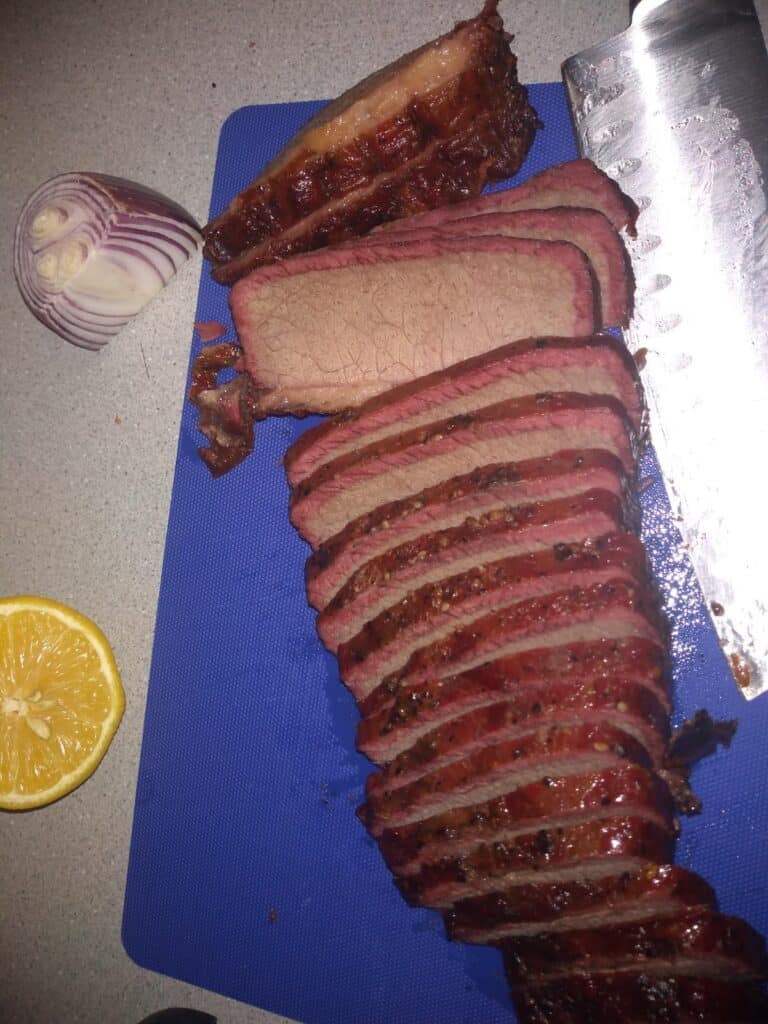My first shot at a brisket, I read some articles and settled on ‘about 1.5 hours per pound’ as the acceptable method to smoke my brisket. Cooking brisket without a meat thermometer is easy if you just follow these directions.
I didn’t need a meat thermometer when smoking a brisket, right?
I’m a smart guy.
Got it all figured out.
Smoking the brisket low and slow
I was in tune with “low and slow” and kept my smoker at around 225, give or take.
I wrapped the brisket in foil at about the 5-hour mark, as after that point, it will not absorb any more smoke. It’s just baking from there on. In fact, I later learned, that it’s entirely acceptable to finish the cook in your kitchen oven at this point.
Purists will scoff, but in reality, it amounts to about the same thing. These days, I often start my cooks in the evening, cook until about 11 pm or midnight, then let them finish in the oven with a steady temp and meat thermometers (and alarms) in place.
Faux cambro
It was an eight-pound brisket so, per my extensive research (obviously, not nearly extensive enough), I pulled the brisket off after 12 hours and promptly wrapped it in a towel and stuffed it in the cooler like everybody says to do.
The “poor man’s” Cambro or “Faux Cambro,” as you’ll see it referenced regularly. A real Cambro is an insulated appliance that real cooks and chefs use to keep food after it’s cooked.
We all know it’s important to rest a brisket before serving, the faux cambro is a popular method of doing so. Aaron has something to say about that:
You could ruin a really, really great cook by poor follow through.
Aaron Franklin, Master Class
Anyway, I left the brisket wrapped in foil, wrapped in two towels, and inside the cooler for about 3 hours until everything else was ready.
Ugly brisket, but still kinda tasty
I called everybody into the kitchen, pulled the brisket out of its resting spot (surprised by how hot it still was!) placed it onto the cutting board, and started slicing.
What do you think it looked like?

Yep, overcooked. The meat, oddly enough, was still a little juicy (although you can’t tell from the picture) but overdone. It didn’t taste terrible but wasn’t what I or the gathering had expected.
That was the last time I tried to smoke a brisket without a meat thermometer.
I’ve since done a lot more study on the subject and realized there are those who can cook briskets without a meat thermometer, but that’s not me. I now rely on them and most likely will continue to.
What I did wrong with my first brisket
What did I do wrong when smoking my first brisket?
- I didn’t use a meat thermometer, so I didn’t know the brisket’s actual internal temp. It was all guesswork. I was also relying on my smoker’s temperature gauge to determine if the smoker was at 225. In the end, it could have ended up severely undercooked, just right, or overcooked. Being the overachiever that I am, mine, of course, ended up overcooked.
- When resting my brisket in the faux cambro, I left it wrapped in butcher paper, then wrapped two heavy-duty towels around it, then put it into a styrofoam cooler, put the lid on it, and let it sit for about 3 hours. It felt as hot, if not hotter when I pulled it out as when I initially put it in there. It wasn’t really resting, it was still cooking from the residual heat – referred to as carry-over cooking. I should have watched the last 5 minutes of Aaron’s master class a little closer.
Lessons learned from smoking my first brisket (burning really, not smoking)
- I have since bought two different meat thermometers and use both every time I cook – yes, I’m now paranoid. I use one in the smoker itself to validate the internal temp and another in the meat I’m cooking. One of my thermometers provides four probes while the other provides two so I can easily double and even triple check the smoker temp and a lot of various meats at the same time. Of course, I also have a handy switchblade style insta-temp probe as well.
- I no longer rest my brisket, as I explained above. In Aaron’s Franklin Master Class, he explains the problem with doing it this way is that it continues to cook and can result in overcooking (I found that out the hard way!). He recommends placing it into the cooler after the rest period to keep it at temp rather than during the rest. Aaron recommends resting until the temp is 140-150 and this can take an hour or two. There’s no real defined timeframe for this. He stresses that if resting on a table outside, for instance, the external temps (wind, humidity, etc.) all play a part in how long it’ll rest before hitting the 140-150 temperature range.
- The larger the cut of meat, the more important the meat thermometer is. Smoking something like a turkey or a prime, or a large brisket, of course, requires a meat thermometer more so than just smoking some burgers or steaks, for example.
I hope that helps!
